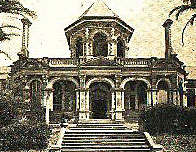
'Cumbooquepa' c.1920 (now Somerville House)
designed by Oakden, Addison & Kemp, 1890-91
[Photograph from the archives of Somerville House]

'Cumbooquepa' c.1920 (now Somerville House)
designed by Oakden, Addison & Kemp, 1890-91
[Photograph from the archives of Somerville House]
Historical and Technical Documentation by Geoffrey Cox
© OHTA 1989, 2012 (last updated February 2012)
Somerville House is a day and boarding school for girls, established in 1899 on Wickham Terrace, Brisbane, as the Brisbane High School for Girls. Owned by the Presbyterian and Methodist Schools Association (PMSA), the school moved to its present location in South Brisbane in 1920. The campus incorporates the residence 'Cumbooquepa', which was designed by the Brisbane architects, Oakden, Addison & Kemp, in 1890-91 for Hon. William Stephens.1
The organ now in Centenary Hall was built in 1888 by A. Hunter and Son, for the Methodist Church, Waverley, in Sydney.2 The builder's plate reads: 'Hunter & Son, Organ Builders, 65A, High Street, Clapham, London'.
Alfred Hunter (1827-1911) had been apprenticed to Holdich, and later worked with Bishop, then Bevington. By 1856 he was working in partnership as 'Hunter & Webb' in Lambeth, but as 'A. Hunter' by about 1866. He had moved to Clapham by 1881 and was in partnership with his son Robert by 1885 as 'A. Hunter & Son'.3 An engraving 'R. Hunter, Voicer, 1888', appears on one of the pipe mouths of this organ.
The action was originally pneumatic, and the original specification comprised 7 stops on the Great, 9 stops on the Swell, 6 stops on the Choir, 2 stops on the Pedal and 6 couplers:
| GREAT Open Diapason Hohl Flote Gamba Principal Flute harmonic Twelfth Fifteenth SWELL Double Diapason Open Diapason Gamba Lieblich Gedact Gemshorn Fifteenth Mixture Cornopean Oboe CHOIR Viol di Gamba Dulciana Lieblich Gedact Suabe Flute Piccolo Clarionet PEDAL Bourdon Open Diapason COUPLERS Great to Pedals Choir to Pedals Swell to Pedals Swell to Great Swell to Choir Octave Swell |
8 8 8 4 4 2-2/3 2 16 8 8 8 4 2 II 8 8 8 8 8 4 2 8 16 16 |
[wood] |
Swell tremulant
Tubular-pneumatic action
Compass: 58/30.4
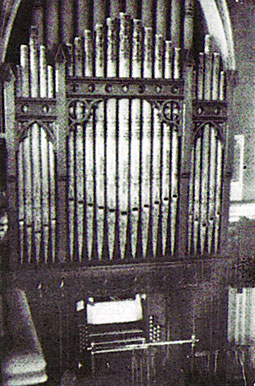
The A. Hunter & Son organ at the Methodist Church, Waverley, NSW
[Photograph from The Sydney Organ Journal,
vol. 32, no. 3 (Winter 2001), p. 20]
The organ was advertised for sale in 1971 after the Waverley church was closed.5 It was purchased by Somerville House, and removed to storage at the school. The instrument was installed in Harker Hall at the school by Whitehouse Bros in 1974-76, located mostly out of sight above the stage of the hall. The original façade was discarded and a detached console provided. The original action was replaced with electro-pneumatic action at this time, and three additional pedal stops (Flute 8ft, Principal 8ft & Principal 4ft) and an additional coupler (Choir to Great) were supplied. The manual compass of 58 notes was increased to 61 notes at the console, although the additional pipes were never added.6 The new Pedal Principal 8ft & 4ft is reported to have derived from the original Open Diapason 8ft by George Benson from the 1889 organ at Albert Street Uniting Church, Brisbane. The Hunter soundboards were left intact with minimal change other than electrification of the action.
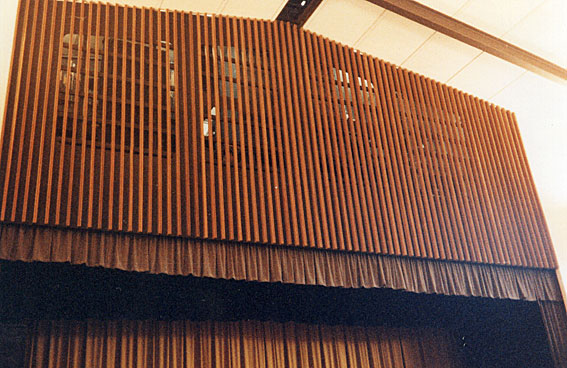
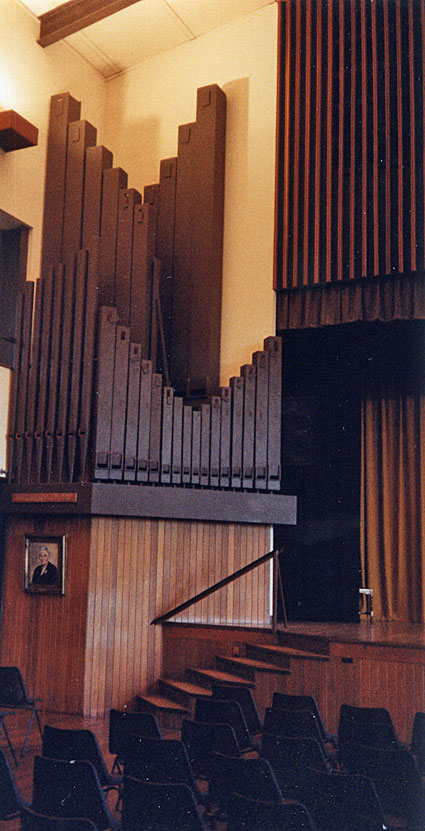
The A.Hunter & Son organ installed in 1976 by
Whitehouse Bros in Harker Hall at Somerville House
[Photographs by Howard Baker (1990s)]
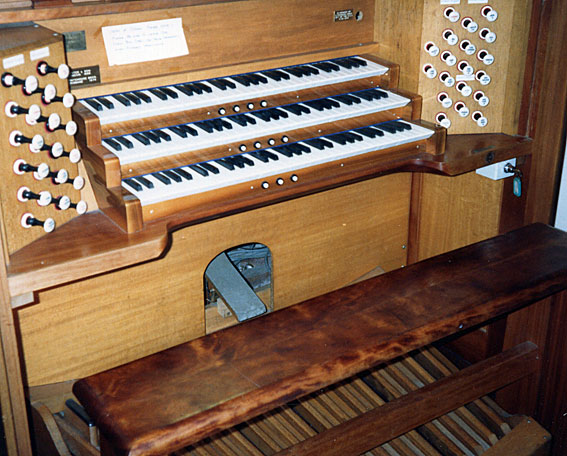
New detached console supplied by
Whitehouse Bros in 1976
[Photograph by Howard Baker (1990s)]
In 1984, J.W. Walker & Sons added four new stops (as shown below), at the same time removing three of the manual string stops (Great Gamba 8ft, Choir Viol di Gamba 8ft & Choir Dulciana 8ft). The Dulciana has since been incorporated into the organ built by Simon Pierce for St George's Anglican Church, Eagle Heights. The organ was refurbished in 1996-97 by W.J. Simon Pierce, and provided with a new wind system. At the same time, the Pedal Open Diapason 16ft (wood) was relocated, and the layout of the instrument was altered.7
Following the centenary of the school in 1999, the entire instrument was reconstructed and moved to the school's new Centenary Hall in 2001 by W.J. Simon Pierce, and the pitch was lowered to A.440. A new recessed draw-stop console and organ case of Tasmanian Oak were provided at this time. The new casework was based loosely on a photograph of the original at Waverley, supplied by Mr Howard Brockington of Lismore.8
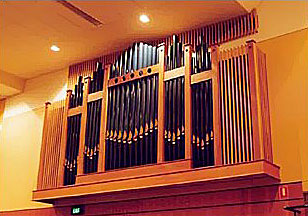
The A. Hunter & Son organ relocated with new casework
by W.J. Simon Pierce to Centenary Hall at Somerville House in 2001
[Photograph by Simon Pierce (c.2001)]
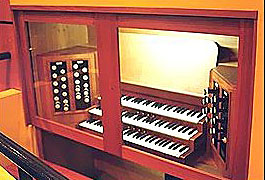
Console of the organ in Centenary Hall after 2001
[Photograph by Simon Pierce (c.2001)]
The resulting specification, which does not entirely preserve the original nomenclature or spelling, is as follows:
| GREAT Open Diapason Hohl Flote Principal Harmonic Flute Twelfth Fifteenth Mixture SWELL Double Diapason Open Diapason Lieblich Gedacht Gamba Gemshorn Fifteenth Mixture Oboe Cornopean CHOIR Lieblich Gedacht Saube Flute Nazard Piccolo Tierce Clarionet PEDAL Open Wood Bourdon Principal Bass Flute Principal Octave [Flute] COUPLERS Great to Pedal Choir to Pedal Swell to Pedal Swell to Great Swell to Choir Choir to Great Swell Super Swell Sub Swell Octave to Pedal |
8 8 4 4 2-2/3 2 III 16 8 8 8 4 2 II 8 8 8 4 2-2/3 2 1-3/5 8 16 16 8 8 4 4 |
[1984] [1984] [1984] A B [1976, ex Albert Street Methodist Church, Benson 1889] A [1976] B [1976, ex Albert Street Methodist Church, Benson 1889] A [1984] [1976] [2001] [2001] |
|
| Swell tremulant 4 pistons to Swell Organ 4 pistons to Great Organ 3 pistons to Choir Organ Electro-pneumatic action Compass: 58/30 Draw-stop console 9 |
[3 until 2001] [3 until 2001] [2001] [2001] |
______________________________________________________________________________
1 Donald Watson & Judith McKay, Queensland Architects of the 19th Century: A Biographical Dictionary (Brisbane: Queensland Museum, 1994), pp. 135-36.
2 Frederick W. Thornsby, ed, Dictionary of Organs and Organists, 2nd edn (London: Mate, 1921), p. 286; Thornsby gives '24 speaking stops, 7 couplers,' although the 6 couplers recorded by F. Rogers agree with the stop-knobs and jambs as noted in footnote 4 below.
3 Personal communication to G. Cox from Bernard B. Edmonds (U.K.), June 1973.
4 Specification noted by Frederic Rogers at Waverley, 1934; nomenclature and spelling given here was checked and corrected against original stop jambs (31 draw-stop holes, including one for the tremulant) and draw-stops (except Choir Suabe Flute 4ft and Swell Mixture II, which could not be found), G. Cox, 1974.
5 The Sydney Organ Journal, vol. 2, no. 5 (May 1971), p. 8.
6 Personal communication to G. Cox from Graeme Morton (Director of Music), 2 June 1975; additional information noted by G. Cox, 1989.
7 Personal communications to G. Cox from W. J. Simon Pierce, 1997 & 2001; The Organ Voice, vol. 23, no. 1 (March 1997), p. 24.
8 The Organ Voice, vol. 26, no. 2 (June 2000), p. 24; The Organ Voice, vol. 26, no. 4 (December 2000), p. 26; The Sydney Organ Journal, vol. 32, no. 3 (Winter 2001), p. 20; The Organ Voice, vol. 27, no. 3 (September 2001), pp. 15-17; OHTA News, [vol. 24], no. 3 (July 2000), p. 7.
9 Specification noted by G. Cox, 1989. Subsequent details incorporated from The Sydney Organ Journal, vol. 32, no. 3 (Winter 2001), p. 20 and The Organ Voice, vol. 27, no. 3 (September 2001), p. 16.